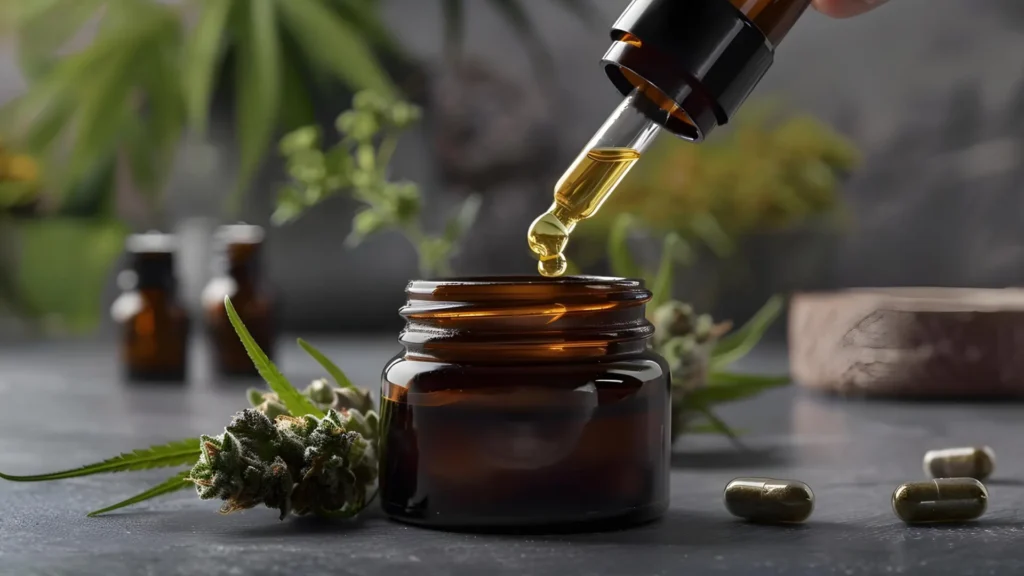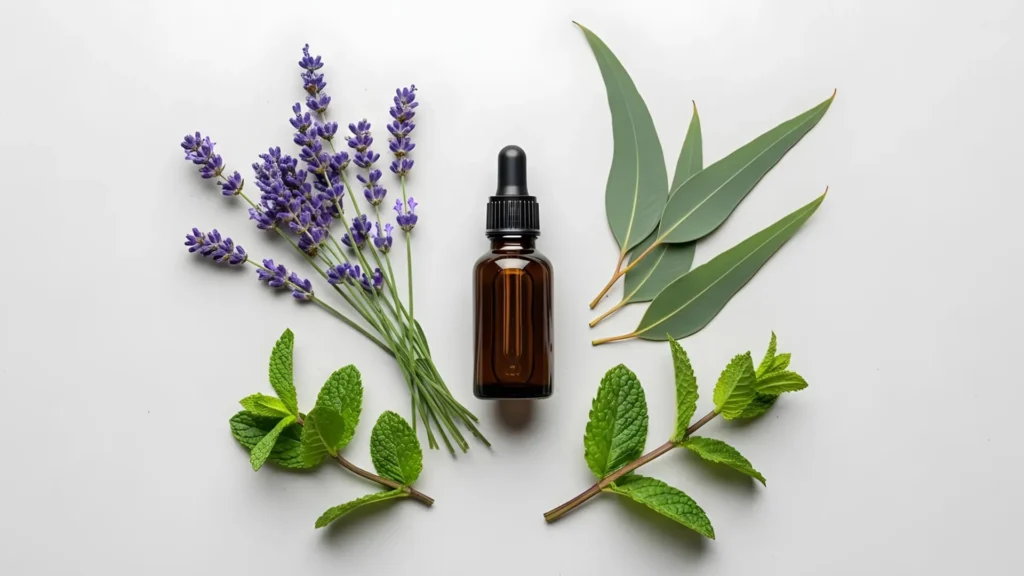Managing chronic pain is frustrating at the best of times. You find something that works for a while, then it stops. Or it comes with side effects you don’t want. I’ve been there. That’s what got me looking more closely at natural ways to handle pain, and I kept hearing about terpenes over and over.
In this post, I’ll share what I’ve learned from personal experience and years of research into terpenes for pain relief. Whether you prefer using cannabis, essential oils, or a combination of both, there are options here worth exploring. You’ll also find safety tips, common questions, and practical ways to use terpenes.
Table of Contents

Understanding Terpenes and Pain Relief
Terpenes are getting a lot more attention these days, especially in natural pain management. But before we get into which ones work best, it helps to understand what they are, where they come from, and how they actually affect pain and inflammation.
What Are Terpenes and How Do They Work?
Terpenes are natural compounds found in plants, especially herbs, citrus fruits, spices, and cannabis. They give each plant its distinct smell and flavour, but they also play an active role in how the plant interacts with your body. Some terpenes help ease pain, reduce inflammation, relax muscles, or improve sleep. That’s why they’re so important when it comes to managing pain naturally.
They work by interacting with receptors in your body, including the same endocannabinoid receptors that cannabinoids like CBD affect. If you use certain terpenes regularly, they can help ease pain, soothe inflammation, and even change how your body reacts to discomfort.
Cannabis Terpenes vs Essential Oil Terpenes
Cannabis is rich in pain-relieving terpenes like Myrcene and Beta-Caryophyllene, but it’s not the only source. Essential Oils (EOs) such as Lavender, Eucalyptus, and Plai contain many of the same compounds. Interestingly, the same terpenes can be found in both essential oils and cannabis strains. That gives you a lot of flexibility when choosing how to use them: aromatherapy, topicals, edibles, or infused oils.

Best Terpenes in Cannabis for Pain and Inflammation
When you’re dealing with cannabis, having the right terpenes can really change how well it works for pain relief. Some terpenes have sedative effects, some reduce inflammation, and others change how your body processes discomfort. Below are the ones I’ve personally found most useful over the years.
Myrcene
Myrcene is one of the most common terpenes in cannabis. It’s also found in hops, lemongrass, and mangoes. It has a musky, earthy smell and is well known for its calming, sedative effects. Myrcene can help relax tight muscles, ease joint pain, and promote better sleep, all of which matter when you’re dealing with chronic pain. Strains high in Myrcene tend to provide a more relaxing experience. Look for OG Kush or Granddaddy Purple.
Beta-Caryophyllene
This spicy terpene shows up in black pepper, cloves, and cinnamon as well as cannabis. Beta-Caryophyllene is unique because it directly binds to CB2 receptors in the endocannabinoid system, which regulates inflammation and pain response. It’s excellent for easing joint pain and dealing with inflammation. You’ll often find it in strains like Girl Scout Cookies and Cookies and Cream.
Limonene
Limonene gives citrus fruits their sharp, fresh scent. It’s commonly found in uplifting cannabis strains and has both anti-inflammatory and anti-anxiety effects. It can be especially helpful when pain is tied up with tension or low mood. Strains with strong Limonene content include Super Lemon Haze and Durban Poison.
Linalool
Best known for its presence in Lavender essential oil, Linalool also appears in some cannabis strains. It helps calm the nervous system, reduce pain perception, and improve sleep. If your pain is stress-related or you’re struggling to unwind, Linalool-rich strains like LA Confidential are worth exploring.
You can read more about specific terpenes in this blog: 14 Top Terpenes in Cannabis and Essential Oils
If you want to buy cannabis seeds with known terpene characteristic, I recommend Blimburn Seeds for quality and global shipping.

Top Essential Oils for Pain and Inflammation
Essential oils (EOs) are highly concentrated plant extracts that are mostly obtained through steam distillation or cold pressing. They can also be produced by solvent extraction or CO2 extraction. They contain the natural aroma and flavour of the plant they are extracted from. These oils are used for various therapeutic benefits in aromatherapy, skin care, and as analgesics.
EOs are not the same as fragrance oils, which are synthetic and do not have any therapeutic benefits. EOs, on the other hand, have been used for centuries for their medicinal properties. They have anti-inflammatory, analgesic, and antispasmodic effects, which make them effective in moderating pain.
They contain terpenes just the same as those in cannabis. You can use them in massage blends, diffuser oils, compresses, or balms. These are my go-to EOs when pain relief is the goal.
Lavender (Lavandula Angustifolia)
Rich in Linalool and calming esters, Lavender EO is one of the most effective natural options for pain relief. It’s gentle, soothing, and helps ease both physical discomfort and emotional tension. I’ve found it especially useful for headaches, period pain, and sleep-related pain issues.
My preference is always high-altitude Lavender grown above 1500 metres. The chemistry changes, and the oil becomes richer in esters, with a sweeter, less camphoraceous scent. You need less of it, and the effect is stronger.
Peppermint (Mentha Piperita)
Peppermint EO has a cooling effect that’s great for sore muscles, nerve pain, and headaches. It contains Menthol and Menthone, both of which help dull pain receptors and reduce inflammation. You can blend it with a carrier oil and apply it to the skin, or use it in this rich Body Butter to soothe tired joints.
Eucalyptus (Eucalyptus Globulus)
Eucalyptus EO is warming and anti-inflammatory. It improves circulation and eases stiffness, making it especially good for arthritis and deep muscle aches. I’ve used it during recovery from surgery, both topically and as a room spray.
There are several species of eucalypts, and my preference has been either Eucalyptus Smithii or Eucalyptus Globulus. Even inhaling Eucalyptus Globulus has been shown to reduce localised inflammation and assist in pain reduction.
Plai (Zingiber Cassumunar)
Part of the ginger family, Plai EO is brilliant for acute and chronic pain. It’s cooling rather than warming and contains strong anti-inflammatory compounds like Terpinen-4-ol and Sabinene. I’ve used it for years on everything from joint pain to muscle injury, and it never fails.
Blend it with carrier oils and use in a massage oil or balm. It combines well with Lavender or Eucalyptus for targeted pain blends.
How to Use Terpenes Safely
Terpenes are powerful natural compounds, but that doesn’t mean more is better. Whether you’re using cannabis or EOs, safety comes down to three things: quality, dosage, and how you apply them. Here’s what to keep in mind.
Using Cannabis Terpenes Safely
Cannabis-derived terpenes are most commonly used through vaping, edibles, or topical oils. If you’re using a strain for pain relief, choose one with a known terpene profile and start with a small dose. Everyone responds differently.
Tips for safe cannabis terpene use:
- Start low and go slow
- Choose whole-plant products, not isolates
- Avoid if pregnant or breastfeeding
- Don’t drive or operate machinery after use
- If you’re on medication, check with your doctor first
Side effects are usually mild but can include dry mouth, dizziness, or drowsiness, especially if combined with THC.
Using Essential Oils Safely
Essential oils are highly concentrated and need to be diluted before use. Most people mix a few drops of essential oil with a carrier oil, such as coconut, almond, or grapeseed oil, before applying it to their skin. This will help to prevent skin irritation and ensure that the oil is absorbed properly. It is also important to use high-quality EOs from reputable sources to ensure their purity and effectiveness.
Tips for safe EO use:
- Always dilute before topical use
- Never ingest EOs
- Do a patch test before using a new oil
- Check contraindications if pregnant, breastfeeding, or on medication
- Avoid applying near the eyes or broken skin
Some EOs (like Peppermint or Clove) can be irritating in high concentrations. If you experience burning, redness, or nausea, wash the area with a carrier oil and stop using that essential oil.
Scientific Evidence for Terpenes and Pain Relief
There’s plenty of anecdotal evidence that terpenes help with pain, but the science is starting to back it up, too. Researchers are beginning to understand how these plant compounds interact with pain pathways, inflammation, and even mood. Here are a few highlights from the current research:

Myrcene and CB2 Activation
Myrcene, present in cannabis and some essential oils, can reduce inflammation and relieve pain by interacting with CB2 receptors. These are the same receptors that play a role in regulating immune response and inflammation. This makes Myrcene especially useful for conditions like arthritis and fibromyalgia.
Linalool for Anxiety and Pain
Linalool, the key compound in Lavender EO, has both calming and analgesic effects. One study found it reduced pain perception and anxiety levels in patients with fibromyalgia, a condition where both nervous system sensitivity and inflammation are high.
Beta-Caryophyllene and Inflammation Control
This terpene is unique because it binds directly to CB2 receptors, without being psychoactive. It’s found in cannabis, black pepper, and Clove EO. Studies show it can help manage chronic inflammation and reduce the need for opioid-based painkillers.
Lavender Inhalation Post-Surgery
A study on post-operative pain found that patients inhaling Lavender essential oil experienced less pain and needed less morphine than the control group. This suggests that even aromatic use of EOs can have a measurable impact on pain.
Eucalyptus for Inflammatory Conditions
Eucalyptus EO, rich in 1,8-Cineole, has been studied for its anti-inflammatory effects. It’s been shown to reduce swelling and muscle soreness, especially after total knee replacement surgery or intense physical activity.
These studies don’t mean terpenes are a miracle cure. But they do suggest that with regular use, the right terpenes can support your body’s natural pain response, especially when used alongside other treatments.
Combining Cannabis and EO Terpenes
Cannabis and EOs don’t need to be used separately. In fact, combining them often gives better results. This is because of something called the entourage effect, where different plant compounds work together to increase each other’s effects.
Infusing cannabis into a carrier oil and adding specific essential oils can create an effective pain-relief oil, balm, or cream. Here’s how to go about it.
How to Make a Terpene-Rich Topical Cream
- Infuse your cannabis
Use decarboxylated cannabis flower and gently infuse it into a carrier oil like Olive, Sweet Almond, or Grapeseed. See How to Make Cannabis Muscle Rub for full instructions. - Choose your EOs based on the issue
- For joint pain: Plai, Lavender, and Peppermint
- For muscle soreness: Eucalyptus and Rosemary
- For nerve pain or tension: Myrrh, Frankincense, and Linalool-rich Lavender
- For joint pain: Plai, Lavender, and Peppermint
- Blend and apply
Add 10 to 15 drops of your chosen EO (or a blend) per 30 ml of infused oil. Mix well and store in a dark glass bottle. Apply as needed to painful areas.
You can read this blog post which talks about more terpenes and How to Make a Terpene-Rich Cream.
Why It Works
You’re targeting the pain from two angles. Cannabis brings cannabinoids and terpenes like Myrcene and Caryophyllene. The EOs add their own anti-inflammatory compounds, help with absorption, and support relaxation through the nervous system and skin.
This is one of the most effective natural pain relief methods I’ve used, effective for both post-exercise soreness and chronic conditions.
Conclusion
Terpenes offer a natural and versatile way to manage pain. These compounds, from cannabis or essential oils, can help reduce inflammation, calm the nervous system, and relieve various discomforts like joint stiffness and nerve pain.
The key is knowing which terpenes work for your specific needs and how to use them safely. Start small, blend mindfully, and pay attention to what your body responds to. You don’t need complicated tools or expensive kits. A simple infused oil with the right EO blend can go a long way.
As always, if your pain is severe or persistent, speak to a professional. Terpenes aren’t a cure-all, but they can be a powerful part of your long-term pain toolkit.
🎧 Listen Instead
Prefer listening? Play it here or catch it on your favourite platform:
FAQ
What are the best terpenes for pain relief and inflammation?
The top terpenes for pain relief include Myrcene, Beta-Caryophyllene, Limonene, and Linalool. These are found in cannabis and many essential oils and are known to help reduce inflammation and ease discomfort.
Do cannabis terpenes really help with pain?
Yes. Terpenes like Myrcene and Beta-Caryophyllene in cannabis interact with receptors in the body that influence pain and inflammation, making them helpful for joint pain, nerve pain, and general discomfort.
Can essential oils provide the same terpene benefits as cannabis?
Many essential oils contain the same terpenes found in cannabis. For example, Lavender has Linalool, and Black Pepper has Beta-Caryophyllene. These can be used topically or in aromatherapy for pain relief.
How do terpenes reduce pain naturally?
Terpenes work by calming inflammation, relaxing muscles, and interacting with the endocannabinoid system. Some also affect neurotransmitters involved in pain perception and stress.
Is it safe to mix cannabis terpenes with essential oils?
Yes, combining cannabis-infused carrier oils with essential oils can enhance pain relief. This approach targets pain through multiple pathways and is safe when properly diluted.
Which cannabis strains have the best terpene profile for pain?
Strains like OG Kush, Granddaddy Purple, Cookies and Cream, and Super Lemon Haze are high in pain-relieving terpenes such as Myrcene, Caryophyllene, and Limonene.
Are there side effects from using terpenes for pain relief?
Possible side effects include drowsiness, dry mouth, skin irritation, or mild nausea. Always dilute essential oils and start cannabis products with a low dose to check your response.
How can I use terpenes for pain without smoking cannabis?
You can infuse cannabis into oil and use it topically or eat it in small amounts. Essential oils can be used in massage blends or diffused. These are non-smoking methods that still offer the benefits of terpenes.

If you liked this blog post, I would love it if you shared it with a friend.
If you use Pinterest, please pin this post.
*As a POT by NOIDS affiliate, I earn from qualifying purchases.
*As an Amazon Associate, I earn from qualifying purchases.


 Spotify
Spotify




